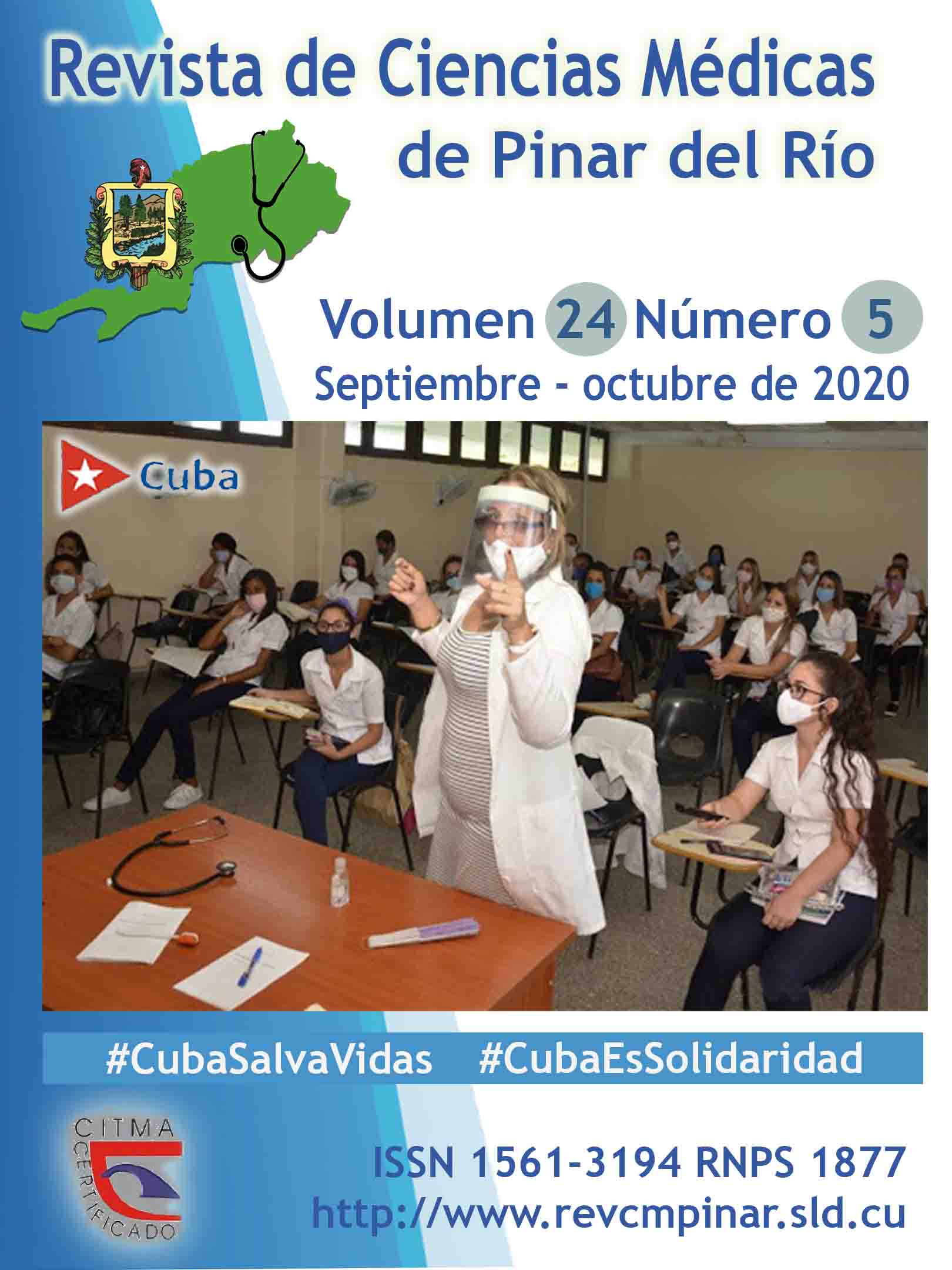Factors influencing the progression of primary angular closure following Laser peripheral iridotomy
Keywords:
LASER THERAPY, GLAUCOMA, ANGLE-CLOSURE, INTRAOCULAR PRESSURE, ANTERIOR CHAMBER.Abstract
ABSTRACT
Introduction: the effects of Laser peripheral iridotomy have been demonstrated; however it does not always manage to control intraocular pressure or the progression of the disease by primary angular closure.
Objective: to analyze the factors influencing the disease progression by primary angular closure in Pinar del Rio patients treated with Laser peripheral iridotomy.
Methods: a retrospective analytical cohort study was carried out in the Ophthalmology Service at Abel Santamaria Cuadrado General Teaching Hospital in Pinar del Río, during 2019. The target group comprised the patients diagnosed with primary angular closure disease treated with Laser peripheral iridotomy and the final sample consisted of 223 eyes from 123 patients. The statistical analysis was performed with the SPSS program.
Results: of the sample (20.6%) experienced disease progression, which was significantly related to the clinical form (p<0.001), age (p=0.012), anterior chamber amplitude (p<0.001), residual angular closure (p<0.001), intraocular pressure (p<0.001) and hypotensive medication (p<0.001). Sex (p=0.427), skin color (p=0.741) and axial length (p=0.549) did not show significant differences.
Conclusions: factors influencing on the progression of the disease by primary angular closure in Pinar del Rio patients who were treated with Laser peripheral iridotomy were: the clinical form, lower anterior chamber amplitude, presence of residual angular closure and intraocular pressure higher than 18 mmHg with the use of more ocular hypotensive eye drops.
Downloads
References
1. EyeWiki [Internet]. San Francisco: American Academy of Ophthalmology; c2019 [consultado 20/02/2020]. Laser Peripheral Iridotomy [aprox. 10p.]. Disponible en: https://eyewiki.org/w/index.php?title=Laser_Peripheral_Iridotomy&oldid=54485
2. Girkin ChA (ed). Basic and Clinical Science Course: Glaucoma 2019-2020. San Francisco: American Academy of Ophthalmology; 2019.
3. Fernández Argones L, Sánchez Acosta L, Cárdenas Chacón D. Cierre angular primario. En: Río Torres M, Fernández Argones L, Hernández Silva JR, Ramos López M. Oftalmología, diagnóstico y tratamiento. 2da ed. La Habana: Ed Ciencias Médicas; 2018. p. 111-15.
4. Yan CH, Han Y, Yu Y, Wang W, Lyu D, Tang Y, et al. Effects of lens extraction versus laser peripheral iridotomy on anterior segment morphology in primary angle closure suspect. Graefes Arch Clin Exp Ophthalmol [Internet]. 2019 [citado 03/03/ 2020]; 257(7): 1473-80. Disponible en: https://pubmed.ncbi.nlm.nih.gov/31079203/
5. Gil-Martínez T, Brazón ME, Cedeño OR, Alfonso C. Variación de la presión intraocular y medidas cuantitativas del segmento anterior pre y posiridotomía en pacientes sospechosos de cierre angular primario. Rev Mex Oftalmol [Internet]. 2019 [citado 21/02/2020]; 93(1):14-8. Disponible en: https://www.medigraphic.com/pdfs/revmexoft/rmo-2019/rmo191c.pdf
6. Krishnadas R. Current management options in primary angle closure disease. Indian J Ophthalmol [Internet]. 2019 Mar [citado 21/02/2020]; 67(3): 321–3. Disponible en: https://doi.org/10.4103/ijo.IJO_1932_18
7. Radhakrishnan S, Chen PP, Junk AK, Nouri-Mahdavi K, Chen TC. Laser Peripheral Iridotomy in Primary Angle Closure. Ophthalmology [Internet]. 2018 Jul [citado 27/02/2020]; 125(7): [aprox. 10p.]. Disponible en: https://doi.org/10.1016/j.ophtha.2018.01.015
8. Sun X, Dai Y, Chen Y, Yu D, Cringle SJ, Chen J, et al. Primary angle closure glaucoma: What we know and what we don`t know. Prog Ret Eye Research [Internet]. 2017 [citado 01/03/2020]; 57:26-45. Disponible en: https://doi.org/10.1016/j.preteyeres.2016.12.003
9. He M, Jiang Y, Huang S, Chang DS, Muñoz B, Aung T, et al. Laser peripheral iridotomy for the prevention of angle closure: a single-centre, randomised controlled trial. Lancet [Internet]. 2019 [citado 28/02/2020]; 393(10181):[aprox. 10p.]. Disponible en: https://pubmed.ncbi.nlm.nih.gov/30878226/
10. Qiu L, Yan Y, Wu L. Cierre angular aposicional y conversión del cierre angular primario en glaucoma después de la iridotomía periférica con láser. Br J Ophthalmology [Internet]. 2018 [citado 28/02/2020]; 104(3): [aprox. 8p.]. Disponible en: http://dx.doi.org/10.1136/bjophthalmol-2018-312956
11. Pose-Bazarra S, Azuara-Blanco A. Role of lens extraction and laser peripheral iridotomy in treatment of glaucoma. Curr Opin Ophthalmol [Internet]. 2018 [citado 28/02/2020]; 29(1): [aprox. 3p.]. Disponible en: https://doi.org/10.1097/ICU.0000000000000435
12. Wang L, Huang W, Huang S, Zhang J, Gui X, Friedman DS, et al. Ten-year incidence of primary angle closure in elderly Chinese: the Liwan Eye Study. Br J Ophthalmol [Internet]. 2019 [citado 02/03/2020]; 103(3): [aprox. 5p.]. Disponible en: https://bjo.bmj.com/content/103/3/355
13. Baskaran M, Yang E, Trikha S, Kumar R, Wong HT, He M, et al. Residual Angle Closure One Year After Laser Peripheral Iridotomy in Primary Angle Closure Suspects. Am J Ophthalmology [Internet]. 2017 Nov [citado 02/03/2020]; 183: 111-7. Disponible en: https://doi.org/10.1016/j.ajo.2017.08.016
14. Thompson AC, Vu DM, Cowan LA, Asrani S. Factors Associated with Interventions after Laser Peripheral Iridotomy for Primary Angle-Closure Spectrum Diagnoses. Ophthalmol Glaucoma [Internet]. 2019 [citado 02/03/2020]; 2(3):192-200. Disponible en: https://doi.org/10.1016/j.ogla.2019.03.003
15. Tan S, Yu M, Baig N, Chan PP, Tang FY, Tham CC. Circadian intraocular pressure fluctuation and disease progression in primary angle closure glaucoma. Invest Ophthalmol Vis Sci [Internet]. 2015 [consultado 02/03/2020]; 56(8):4994–5005. Disponible en: http://iovs.arvojournals.org/article.aspx?articleid=2422137
Downloads
Published
How to Cite
Issue
Section
License
Authors who have publications with this journal agree to the following terms: Authors will retain their copyrights and grant the journal the right of first publication of their work, which will be publication of their work, which will be simultaneously subject to the Creative Commons Attribution License (CC-BY-NC 4.0) that allows third parties to share the work as long as its author and first publication in this journal are indicated.
Authors may adopt other non-exclusive license agreements for distribution of the published version of the work (e.g.: deposit it in an institutional telematic archive or publish it in a volume). Likewise, and according to the recommendations of the Medical Sciences Editorial (ECIMED), authors must declare in each article their contribution according to the CRediT taxonomy (contributor roles). This taxonomy includes 14 roles, which can be used to represent the tasks typically performed by contributors in scientific academic production. It should be consulted in monograph) whenever initial publication in this journal is indicated. Authors are allowed and encouraged to disseminate their work through the Internet (e.g., in institutional telematic archives or on their web page) before and during the submission process, which may produce interesting exchanges and increase citations of the published work. (See The effect of open access). https://casrai.org/credit/



